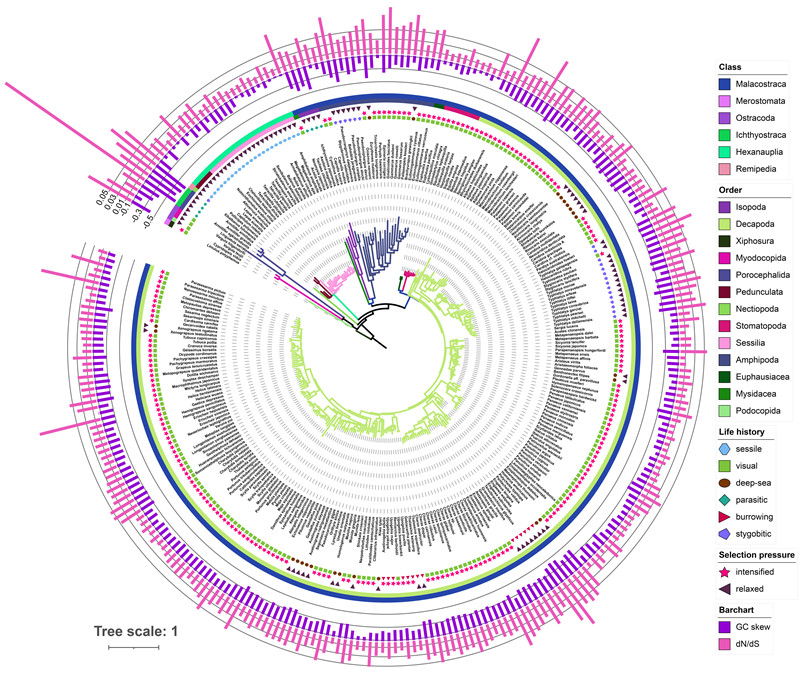
Newsroom
Slow Crabs – Fast Genomes: Locomotory Capacity Predicts Skew Magnitude in Crustacean Mitogenomes

Phylogeny, life history, relaxed/intensified selection, order, class, GC skew, and ω (dN/dS) values (from inside to outside) of all 287 crustacean species used in the analyses. (Image by IHB)
The long-prevailing paradigm of the adaptive evolution of organism complexity has been challenged in the last two decades by a competing theory that nonadaptive processes are the major driver of evolutionary patterns. Mitochondrial genomes (mitogenomes) were not spared this proposed paradigm shift, as their evolution in animals is suggested to be driven primarily by two nonadaptive forces - random genetic drift and mutation pressure. The latter, mutation pressure, is also believed to be the primary force driving base composition skews (G-C/G+C and A-T/A+T) of mitochondrial genomes.
The research group led by Prof. WANG Guitang from the Institute of Hydrobiology (IHB) of the Chinese Academy of Sciences provided evidence to the contrary. They found that interlineage variability in skew magnitude is primarily driven by adaptive forces. The results were published in Molecular Ecology.
Wang’s team first observed that crustaceans with life histories that require low locomotory capacity are associated with elevated skew magnitudes. As previous studies have shown that metabolic rate is positively correlated with locomotory capacity in marine animals, this contradicted the hypothesis that skews are primarily a product of the metabolic rate.
Given the central role of mitochondria in energy metabolism, the researchers hypothesised that selection for locomotory capacity should be positively correlated with the strength of purifying selection (dN/dS) acting on the mitogenome, and thus be negatively correlated with the skew magnitude.
They set out to test this hypothesis by determining the relative impacts of a number of different variables previously associated with mitogenomic evolution on skew magnitude. Multilevel regression analyses indicated that selection for locomotory capacity was the best predictor of skew magnitude, while three competing variables, body size (associated with the metabolic rate), gene order rearrangement rate, and effective population size, had negligible impacts.
These results support the hypothesis that skew magnitude is primarily a product of the strength of purifying selection, i.e. the adaptive evolution. In more detail, despite their lower metabolic rates, the mitogenomes of weakly locomotory taxa exhibit higher mutation rates and overall skew magnitude because they are evolving under weakened purifying selection pressures in comparison to highly locomotory taxa. As a result, instead of the expected positive association between the metabolic rate and mitochondrial skew magnitude, crustaceans exhibit a negative correlation between these two parameters.